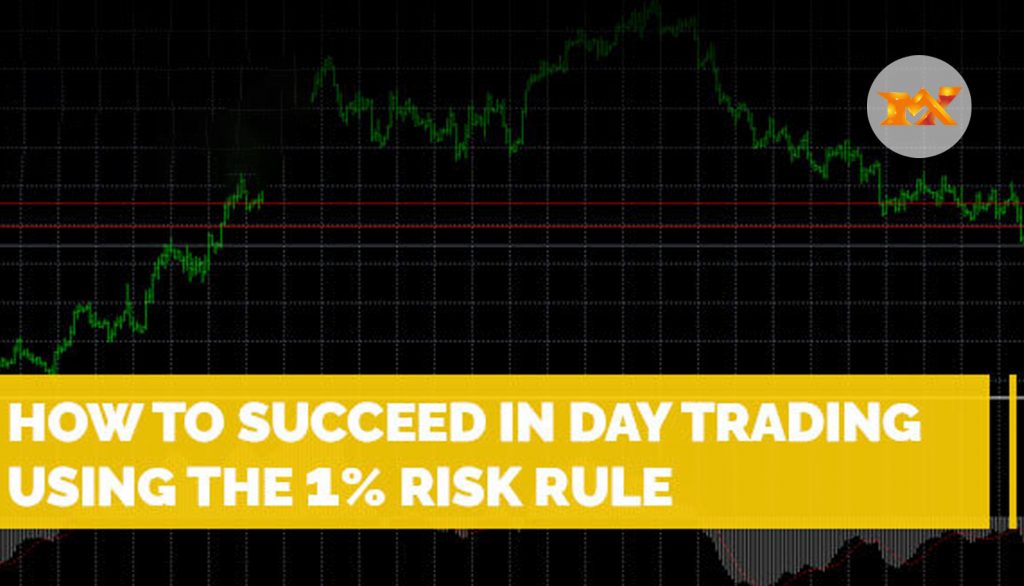Risk Rule to Win at Day Trading

![]()
Why should every trader be aware of this 1% risk rule and what it is? What is the rule’s advantage? When trading, there are several techniques to reduce risks and losses. The 1% risk rule is just one of them.
We’ll take on this responsibility of explaining the 1 percent rule to you and how it can benefit you.
What Does the 1% Risk Rule Mean?
The 1 percent method of trading is a well-liked strategy for hedging against significant losses on your investment. With this strategy, the trader never exposes more than 1% of his investment capital to danger. The primary goal of this rule is protection; by abiding by it, you are not taking any additional risks.
Why Applying The “1% Rule” Might be Beneficial To Your Success?
The 1 percent rule is an excellent strategy to prevent traders from suffering significant losses. By restricting the amount of money invested in each trade, this technique will assist both novice and seasoned traders in playing it safe and lowering their chance of financial loss.
When Should You Apply The 1 Percent Rule?
The most skilled trader cannot control anything besides risks.
Gambling is not trading. Your aim as a trader is to manage risk and continue playing. You are better off playing cards at a blackjack table or slot machines close to Las Vegas if you want double counts on every trade.
When you are a beginner, one bad trade might wipe out your entire trading account. In a situation like this, there are only two possible outcomes: either you make a decision based on emotion or you never open positions again.
To prevent chafing and increase your revenues instead, utilize the 1 percent rule.

How Does The 1% Risk Rule Function? Example
Let’s Examine The 1% Risk Guideline Using The Following Example:
Say you had $60,000 to put into investments. A $300 asset purchase does not always limit you to two (60.000*0.01 = 600, 600/300 = 2)
Assuming you agree with the criteria, you just have to close your account if the loss is greater than 1% (in our example, $300). In this situation, all you need to do is know where to put the stop-loss order.
Establish Stop-Loss Orders
Your stop losses must be set when trading so that they will shield you from any potential lethal moves. A stop loss order is one that immediately terminates a trade when the price hits a particular threshold. They are often set at the highest possible risk level.
Stop-loss is an excellent risk management strategy, particularly in forex trading. Here is a list of brokers with guaranteed stop loss orders.
Different Stop-Loss Order Types
Stop-loss Orders Come in 4 Different Varieties. Let’s Get to know Each Other:
Percent Halts
By using a percentage stop-loss, you can prevent losing more money than you initially put up. In other words, it’s expressly created with smaller holdings in mind. For instance, if a trader wishes to risk 1 percent, they might set an order at such levels to prevent losses from exceeding this percentage of their whole trading account balance.
Chart Halts
Chart stops are a terrific technique to make sure that if the markets start moving in the opposite direction, your trades do not go against you. It all depends on how they are set up, but they can be positioned above or below significant levels that might change depending on what is happening with other assets at particular points in time, such as Fibonacci ratios and Pivot Points, which some traders even use for protection within their trading plan.
Volatilities End
The volatility stop-loss is an additional stop-loss option for traders. This sort is based on well-liked indicators like ATR and is dependent on how volatile an instrument’s price has been recently (Average True Range). If a trade was expected to move more than expected, for instance, you could set a limit that was 1/2 times higher than what would normally be advised. However, this only works when taking positions that are quite large in size; smaller trades should never disregard the ATR position setting that comes first.
Time Halts
You can avoid overnight losses and holding trades over the weekend without affecting how much profit is made by knowing when these orders will be active.
Exceptions to the “1% Rule”
Trading in marketplaces with little liquidity might make it challenging to adhere to the one percent rule. For instance, it will take more than simply 1 percent to trade $10K worth of oil futures contracts if the spot price stays at $50 per barrel for ten straight days with no buying or selling activity. Due to their low liquidity factor, which is a result of their low market capitalizations, orders of less than 10% may not be successful in this manner (high trading volume).
1 Percent Risk Rule Summary
One of the worst errors that novice investors make is placing large bets only to lose everything in an instant. Trading firms employ the 1 percent rule to combat this. By reducing the hazards, it helps to reduce the number of deaths.
The one percent rule is comparable to Forex trading’s Negative Balance Protection feature, which locks out traders whose capital goes below zero. Learn more about Forex Brokers with Negative Balance Protection here.







Successful forex trading strategy - Milliva
04th Aug 2022[…] practice of exchanging currencies during a single trading day is referred to as day trading. Though useful in many markets, the day trading method is most frequently utilized in the forex […]
Understanding the Different Types of Forex Trading
16th Aug 2022[…] are some strategies to do forex trading they are scalping, day trading, swing trading, momentum trading and position trading. As we already seen, for every trading the […]
What is the Best Trading Strategy for Small Accounts?
15th Oct 2022[…] profitable trading is one of the way, but if you are being conservative and adhering to the 1% risk rule, then the growth may occur more gradually than you would like. You can take higher risk or reward […]